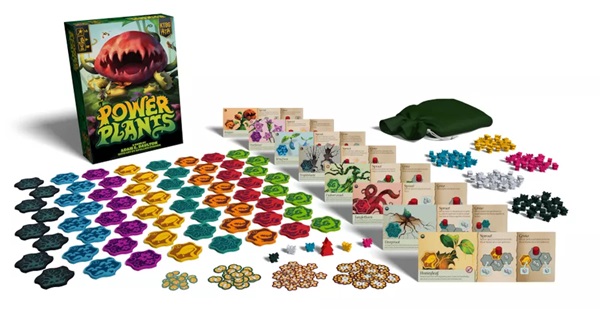Grow Magical Greenery and Compete for Their Control in Power Plants

It’s hard being a wizard who has to share a communal garden. You want to keep all the best plants for yourself, but those other pesky wizards are eying them, too! With the help of your magical sprites, and the plants themselves, you might just be able to lay claim to the best spell components.
Published by Kids Table Board Games (KTBG), Power Plants is a 30-minute game for 1-5 players. While the box says it is for ages 8 and up, this is probably a game best suited for slightly older children and adults.
Gameplay
There are eight types of plant tiles in the box, but for each game players only select five of them to play with. Each set of plant tiles is numbered 1-8.
On a player’s turn he chooses one of the two plant tiles in his hand and adds it to the board. He may then either use the plant ability of the tile he just placed or the sprout abilities of each plant tile that it is now touching. Typically, sprout abilities are more powerful, but being able to trigger multiple growth abilities can be quite a good move. The player then ends his turn by drawing a new tile from the bag to add to his hand.
Each plant in the game has a unique sprout and grow ability. Most abilities revolve around sprites, either placing them or moving them. Each player has 20 sprites in his player color. There is no limit as to how many sprites a player can have on a tile, but two players cannot have a sprite on the same tile. If a player would add a sprite to a tile that another player has at least one on already, he does not add his sprite to that tile but instead removes one of his opponent’s. Having a sprite on a tile counts means you control that tile.
The game ends once the final tile is drawn from the bag and every player has taken a final turn. Then points are calculated.
Sets of matching tiles that are connected form a field. The player who controls the most tiles in a field scores the most points for that field. The number of points is based on how many tiles are in that field. The player who controls the second most also scores some points. Any other player who controls at least one tile in that field scores one point. The number of sprites players have in a field is not important: only how many tiles they each control within it. If there is a tie, the tie is broken by the player who controls the tile with the lower number written on it.
Some plant types also have additional end-game scoring rules, and some plant abilities will also place gems on tiles during the game. Gems count as points and are won by the player whose sprite controls their tile at the end of the game. Some plants also award players gems during the game itself. All points are added up and the player with the most points wins.

Review
Power Plants is a very strategic game and is a good workout for your brain — players vie for control of the fields, figure out the best tiles placements, and choose between growth and sprout abilities. The mechanic of choosing to activate either the played tile or the adjacent tiles is so clever and makes the game instantly engaging.
The basic rules here are simple: you place a tile and activate abilities. However, this is a game that is going to take time to learn and play smoothly. There are a lot of powers in this game, and since each plant has two different ones, that’s 10 powers to learn and remember every time you play. Then there are eight plants in the box, and each plant also has an advanced variant.
All of this means that players do spend some time consulting the cheat sheets for the plants while they’re playing, trying to remember what their options are, and that does slow down the game a little. At five players, you’re going to be waiting a while, especially at first, for it to come around to your turn again. Since the board is constantly evolving, you can’t really plan ahead with your turn.
The powers are all quite interesting and all play in unique ways. For some, the placement of the tile in relation to all the other tiles on the board is important, while others allow you to capture an opponent’s sprite. The placement of gems also evolves the board and changes which fields or tiles are more valuable to go after.
There is a lot of take-that in this game. Players are constantly having direct interaction with each other, moving each other’s sprites, jostling for control. Many of the plant powers directly impact other players, especially since attempting to place a sprite on a tile where another player already has one results in the removal of both.
The components for this game are well done and we liked the artwork on the plants. The tiles are lightweight but colorful and attractive. The tile bag is also well-made, and the game just looks appealing as the tiles start to spread out across the board.
If you enjoy board games with a lot of take-that, Power Plants is strategic and surprisingly deep. The core mechanic at its heart is excellent, the scoring system is tidy and leads to fun decisions, and the result is a solid game that makes you think.
Pros: The growth/sprout mechanic is excellent, nice aesthetics, different plant abilities to add variety between games
Cons: Downtime at higher player counts, learning all the powers takes some time, the amount of take-that won’t be for everyone
Disclosure: we received a complimentary review copy of this game.






